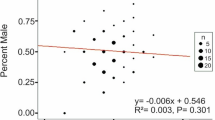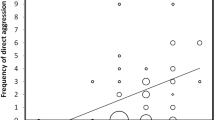Abstract
In social species, the hierarchical status of an individual has important consequences for its fitness. While many studies have focused on individual condition to explain access to dominance, very few have investigated the influence of the social environment, especially during early life. Yet it is known that environmental conditions early in life may influence several traits at adulthood. Here, we examine the influence of early social environment on accession to dominance by investigating the influence of litter size and sex composition on survival and the probability of ascending to dominance later in life using a 20-year dataset from a wild population of Alpine marmots (Marmota marmota). Although litter size had no effect on the fate of individuals, litter sex composition affected male juvenile survival and both male and female probabilities of reaching dominant status when adult. Male juveniles incur lower survival when the number of male juveniles in the litter increases, and individuals of both sexes from male-biased litters are more likely to become dominant than individuals from female-biased litters. However, the absolute number of sisters in the litter, rather than the sex ratio, seems to be an important predictor of the probability of acquiring dominant status: pups having more sisters are less likely to become dominant. Several potential mechanisms to explain these results are discussed.



Similar content being viewed by others
References
Allainé D (2004) Sex ratio variation in the cooperatively breeding Alpine marmot Marmota marmota. Behav Ecol 15:997–1002
Allainé D, Theuriau F (2004) Is there an optimal number of helpers in Alpine marmot family groups? Behav Ecol 15:916–924
Allainé D, Graziani L, Coulon J (1998) Postweaning mass gain in juvenile Alpine marmots Marmota marmota. Oecologia 113:370–376
Allainé D, Brondex F, Graziani L, Coulon J, Till Bottraud I (2000) Male-biased sex ratio in litters of Alpine marmots supports the helper repayment hypothesis. Behav Ecol 11:507–514
Arnold W (1988) Social thermoregulation during hibernation in Alpine marmots (Marmota marmota). J Comp Physiol [B] 158:151–156
Arnold W (1993) Social evolution in marmots and the adaptive value of joint hibernation. Verh Dtsch Zool Ges 86:79–93
Baker MC, Belcher CS, Deutsch LC, Sherman GL, Thompson DB (1981) Foraging success in junco flocks and the effects of social hierarchy. Anim Behav 29:137–142
Bautista A, Drummond H, Martínez-Gómez M, Hudson R (2003) Thermal benefit of sibling presence in the newborn rabbit. Dev Psychobiol 43:208–215
Bel MC, Porteret C, Coulon J (1995) Scent deposition by cheek rubbing in the Alpine marmot (Marmota marmota) in the French Alps. Can J Zool 73:2065–2071
Burnham K, Anderson D (2002) Model selection and multimodel inference: a practical information-theoretic approach, 2nd edn. Springer, New York
Burnham KP, Anderson DR, Huyvaert KP (2011) AIC Model Selection and multimodel inference in behavioral ecology: some background, observations, and comparisons. Behav Ecol Sociobiol 65:23–35
Cam E, Monnat J-E, Hines JE (2003) Long-term fitness consequences of early conditions in the kittiwake. J Anim Ecol 72:411–424
Charnov EL, Ernest SM (2006) The offspring-size/clutch-size trade-off in mammals. Am Nat 167:578–582
Choquet R, Lebreton J-D, Gimenez O, Reboulet A-M, Pradel R (2009a) U-CARE: utilities for performing goodness of fit tests and manipulating CApture-REcapture data. Ecography 32:1071–1074
Choquet R, Rouan L, Pradel R (2009b) Program E-Surge: a software application for fitting multievent models. In: Thomson DL, Cooch EG, Conroy MJ (eds) Modeling demographic processes in marked populations, vol 3. Springer, New York, pp 845–865
Clemens LG, Gladue BA, Coniglio LP (1978) Prenatal endogenous androgenic influences on masculine sexual behavior and genital morphology in male and female rats. Horm Behav 10:40–53
Clutton-Brock TH, Albon SD, Guinness FE (1986) Great expectations: dominance, breeding success and offspring sex ratios in red deer. Anim Behav 34:460–471
Cohas A, Yoccoz N, Da Silva A, Goossens B, Allainé D (2006) Extra-pair paternity in the monogamous Alpine marmot (Marmota marmota): the roles of social setting and female mate choice. Behav Ecol Sociobiol 59:597–605
Cohas A, Bonenfant C, Allainé D, Gaillard JM (2007) Are extra-pair young better than within-pair young? A comparison of survival and dominance in Alpine marmot. J Anim Ecol 76:771–781
Correa LA, Frugone MJ, Soto-Gamboa M (2013) Social dominance and behavioral consequences of intrauterine position in female groups of the social rodent Octodon degus. Physiol Behav 119:161–167
Creel S, Creel NM, Mills MG, Monfort SL (1997) Rank and reproduction in cooperatively breeding African wild dogs: behavioral and endocrine correlates. Behav Ecol 8:298–306
Dewsbury DA (1990) Fathers and sons: genetic factors and social dominance in deer mice, Peromyscus maniculatus. Anim Behav 39:284–289
Douhard M, Gaillard JM, Delorme D, Capron G, Duncan P, Klein F, Bonenfant C (2013) Variation in adult body mass of roe deer: early environmental conditions influence early and late body growth of females. Ecology 94:1805–1814
Ellis L (1995) Dominance and reproductive success among nonhuman animals: a cross-species comparison. Ethol Socio 16:257–333
Even MD, Dhar MG, Vom Saal FS (1992) Transport of steroids between fetuses via amniotic fluid in relation to the intrauterine position phenomenon in rats. J Reprod Fertil 96:709–716
Fadem BH, Tesoriero JV (1986) Inhibition of testicular development and feminization of the male genitalia by neonatal estrogen treatment in a marsupial. Biol Reprod 34:771–776
Farand E, Allainé D, Coulon J (2002) Variation in survival rates for the Alpine marmot (Marmota marmota): effects of sex, age, year, and climatic factors. Can J Zool 80:342–349
Golla W, Hofer H, East ML (1999) Within-litter sibling aggression in spotted hyaenas: effect of maternal nursing, sex and age. Anim Behav 58:715–726
Goossens B, Graziani L, Waits LP, Farand E, Magnolon S, Coulon J, Bel MC, Taberlet P, Allainé D (1998) Extra-pair paternity in the monogamous Alpine marmot revealed by nuclear DNA microsatellite analysis. Behav Ecol Sociobiol 43:281–288
Grimm V, Dorndorf N, Frey-Roos F, Wissel C, Wyszomirski T, Arnold W (2003) Modelling the role of social behavior in the persistence of the Alpine marmot Marmota marmota. Oikos 102:124–136
Hackländer K, Arnold W (1999) Male-caused failure of female reproduction and its adaptive value in Alpine marmots (Marmota marmota). Behav Ecol 10:592–597
Hackländer K, Arnold W (2012) Litter sex ratio affects lifetime reproductive success of free living female Alpine marmots Marmota marmota. Mammal Rev 42:310–313
Hackländer K, Mostl E, Arnold W (2003) Reproductive suppression in female Alpine marmots, Marmota marmota. Anim Behav 65:1133–1140
Hansen BT, Slagsvold T (2004) Early learning affects social dominance: interspecifically cross-fostered tits become subdominant. Behav Ecol 15:262–268
Hodge SJ, Manica A, Flower TP, Clutton-Brock TH (2008) Determinants of reproductive success in dominant female meerkats. J Anim Ecol 77:92–102
Jonart LM, Hill GE, Badyaev AV (2007) Fighting ability and motivation: determinants of dominance and contest strategies in females of a passerine bird. Anim Behav 74:1675–1681
Lardy S (2012) Evolutionary consequences of intra-sexual competition in social species. The example of the Alpine marmot (Marmota marmota). PhD thesis, Université Claude Bernard Lyon 1, Lyon
Lardy S, Cohas A, Figueroa I, Allainé D (2011) Mate change in a socially monogamous mammal: evidences support the ‘‘forced divorce’’ hypothesis. Behav Ecol 22:120–125
Lebreton J-D, Burnham KP, Clobert J, Anderson DR (1992) Modeling survival and testing biological hypotheses using marked animals: a unified approach with case studies. Ecol Monogr 62:67–118
Lee PC, Bussière LF, Webber CE, Poole JH, Moss CJ (2013) Enduring consequences of early experiences: 40 year effects on survival and success among African elephants (Loxodonta africana). Biol Lett 9:20130011
Lindström J (1999) Early development and fitness in birds and mammals. Trends Ecol Evol 14:343–348
Mendi M (1988) The effects of litter size variation on mother-offspring relationships and behavioural and physical development in several mammalian species (principally rodents). J Zool 215:15–34
Metcalfe NB, Monaghan P (2001) Compensation for a bad start: grow now, pay later? Trends Ecol Evol 16:254–260
Monclus R, Blumstein DT (2012) Litter sex composition affect life-history traits in yellow-bellied marmots. J Anim Ecol 81:80–86
Monclus R, von Holst D, Blumstein DT, Rödel HG (2014) Long-term effects of litter sex ratio on female reproduction in two iteroparous mammals. Funct Ecol 28(4):954–962
Packer C, Gilbert DA, Pusey AE, O’Brien SJ (1991) A molecular genetic analysis of kinship and cooperation in African lions. Nature 351:562–565
Poisbleau M, Fritz H, Valeix M, Perroi PY, Dalloyau S, Lambrechts MM (2006) Social dominance correlates and family status in wintering dark-bellied brent geese, Branta bernicla bernicla. Anim Behav 71:1351–1358
Pollock KH, Hines JE, Nichols JD (1985) Goodness-of-fit tests for open capture–recapture models. Biometrics 41:399–410
Pradel R (2005) Multievent: an extension of multistate capture recapture models to uncertain states. Biometrics 61:442–447
Ryan BC, Vandenbergh JG (2002) Intrauterine position effects. Neurosci Biobehav Rev 26:665–678
Sapolsky RM (2005) The influence of social hierarchy on primate health. Science 308:648–652
Stephens P, Frey-Roos F, Arnold W, Sutherland W (2002) Model complexity and population predictions. The Alpine marmot as a case study. J Anim Ecol 71:343–361
Uller T, Massot M, Richard M, Lecomte J, Clobert J (2004) Long-lasting fitness consequences of prenatal sex ratio in a viviparous lizard. Evolution 58:2511–2516
Vom Saal FS, Quadagno DM, Even MD, Keisler LW, Keisler DH, Khan S (1990) Paradoxical effects of maternal stress on fetal steroids and postnatal reproductive traits in female mice from different intrauterine positions. Biol Reprod 43:751–761
Vom Saal FS, Clark MM, Galef BG Jr, Drickamer LC, Vandenbergh JG (1999) Intrauterine position phenomenon in Encyclopedia of reproduction vol.2. Academic, London
Yearsley JM, Kyriazakis I, Gordon IJ (2004) Delayed costs of growth and compensatory growth rates. Funct Ecol 18:563–670
Zielinski WJ, Vom Saal FS, Vandenbergh JG (1992) The effect of intrauterine position on the survival, reproduction and home range size of female house mice (Mus musculus). Behav Ecol Sociobiol 30:185–191
Acknowledgments
We thank all students involved in the trapping of Alpine marmots at La Sassière. We warmly thank all Earthwatch volunteers for their help. Thanks are also extended to authorities of the Vanoise National Park for allowing us to work in the Grande Sassière Nature Reserve. Finally, we thank Earthwatch Institute for financial support. The experiments conducted comply with current French laws. All the handling and sampling were done by A.C. and S.L. who are authorized for experimentation with animals by the French Ministry of Agriculture and Fisheries (diploma nos 0ETRY20090520 and 433R45GRETAF110). The protocol was approved by the ethical committee of the University Claude Bernard Lyon 1 no. BH2012-92 V1.
Conflict of interest
The authors declare that they have no conflict of interest.
Author information
Authors and Affiliations
Corresponding author
Additional information
Communicated by Janne Sundell.
Electronic supplementary material
Below is the link to the electronic supplementary material.
442_2015_3375_MOESM1_ESM.pdf
Online resource 1: Genetic and kinship analyses. Online resource 2: Fate diagram and recapture histories construction. Online resource 3: Multi-Event model construction using E-SURGE. Online resource 4: Goodness Of Fit tests and selection of the root model. (PDF 598 kb)
Rights and permissions
About this article
Cite this article
Dupont, P., Pradel, R., Lardy, S. et al. Litter sex composition influences dominance status of Alpine marmots (Marmota marmota). Oecologia 179, 753–763 (2015). https://doi.org/10.1007/s00442-015-3375-6
Received:
Accepted:
Published:
Issue Date:
DOI: https://doi.org/10.1007/s00442-015-3375-6




